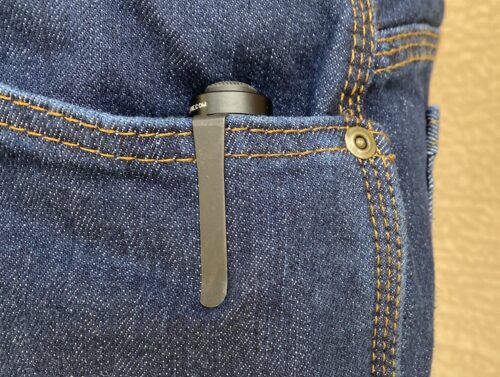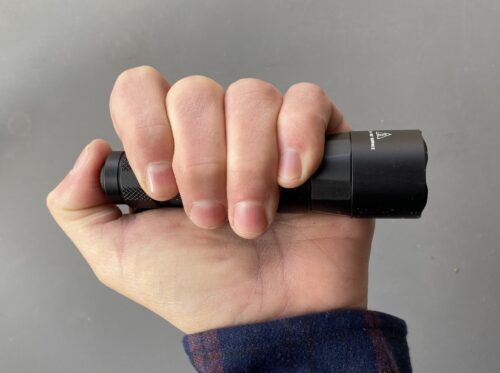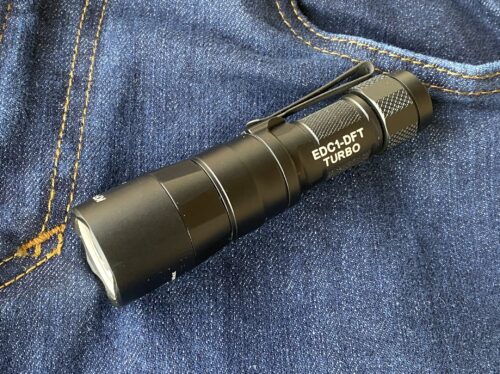SureFire EDC1-DFT Turbo.
When it comes to enhancing your personal safety measures, one crucial tool often goes unnoticed — the flashlight. A flashlight, often seen only as a simple tool for illumination, can also serve as an effective defensive tool. It should be part of your everyday carry (EDC)
If you carry a smartphone, you might question the necessity of having an additional flashlight. Why lug around a separate flashlight as part of your EDC when your phone already has one incorporated? I have often heard this often stated, even from some in law enforcement regarding off-duty flashlight carry. While the light on a phone is certainly useful for many tasks, it all comes down to performance. A phone light simply lacks the capabilities a good flashlight can provide. For personal defense, it’s a no-brainer.
A powerful flashlight can be a force option. While a flashlight may not incapacitate an attacker as other weapons might, its capabilities are extensive and it should be a staple in every person’s self-defense arsenal, regardless of whether they carry a gun or not. If you do carry a gun, a flashlight is vital. In any case, an EDC flashlight should be a constant companion. And with today’s easily pocketed tactical flashlights, there’s no excuse not to.

Legal Practically Everywhere
Flashlights are in general universally legal. A flashlight may be carried in many places where weapons are prohibited, because it’s a tool. If you carry a firearm, you’re aware of the numerous Gun Free Zones, which can leave you feeling exposed. However, a flashlight is completely legal and can be conveniently carried in a pocket or bag without attracting attention. This means you can take it with you in places where you may not be allowed to carry a gun or other weapons.
But, as with everything, there are exceptions. For example, flashlights are allowed by the TSA in both carry-on bags and checked bags, but the final decision rests with the individual TSA officer on whether an item is allowed through the security checkpoint. Size and weight are factors in determining whether it will be allowed. Although not stated on the TSA website as of this writing, flashlights over 7 inches (could be used as a bludgeon) or with any weapon capabilities will not be allowed. The “weapon capabilities” category is very arbitrary in practice. A tactical flashlight will very likely fall into the prohibited category. Best to put it in checked luggage.
Defensive Applications
The best way to handle danger is to avoid it in the first place. When this is impossible, the best way to handle danger is to stay ahead of the reaction curve. One of the main defensive applications of a flashlight is to detect potential dangers in dimly lit environments. The intense light from a flashlight can pierce through the dark, uncovering concealed nooks and shadowy areas where potential threats may be hiding. This can provide you with a considerable edge, enabling you to identify risks before they escalate into threats. Sufficient illumination is necessary to find, recognize, assess, and if necessary, engage threats. Even in daytime, there are numerous instances where you might encounter conditions of diminished or uneven lighting.
Although technological advances have led to ultra-compact weapon-mounted lights suitable for concealed carry applications, having a weapon-mounted light doesn’t eliminate the need to carry a flashlight. A flashlight is still essential for general illumination tasks and as a backup. A weapon-mounted light is part of the weapon system and needs to be treated as such. It’s an adjunct to a flashlight and not a replacement for it. If you’re not justified in drawing and pointing your gun, you’re not justified in pointing a weapon-light. A flashlight allows you to safely assess the situation without pointing your gun at a non-threat.
A flashlight should be in your hand anytime you are navigating in potential diminished lighting scenarios where any threat may be present or hiding. There are no legal restrictions on using flashlights. For instance, if someone is approaching you at night and you can’t determine their intentions, it’s perfectly legal to pull out your flashlight if it’s not in your hand already, turn it on, and point it towards them. This allows you to identify the person and prepare for defense if necessary. If they pose no threat, apologies may be in order, but no harm is done. No law is broken.

Another significant advantage of flashlights is their range. The primary objective in self-defense is always to avoid conflict. A flashlight allows you to spot potential threats from a distance and steer clear of them. The further away we can keep from an attacker, the better. The aim is to extricate ourselves from a dangerous situation before it escalates, rather than having to fight our way out.
Less-lethal self-defense tools like pepper spray, ECWs such as TASER®s, or batons require you to be within close proximity of the attacker. Do I recommend carrying a less-lethal option such as pepper spray where legal? Absolutely. But this doesn’t negate the need for also carrying a good flashlight.
When we are talking personal defense, candela reigns supreme. Lumens are a measure of the total amount of visible light emitted by a source. Candela is the measure of luminous intensity in a given direction. It’s a force multiplier. Not only can it act as a deterrent to potential threats, but an unexpected beam of intense light can also startle and confuse an attacker, giving you precious seconds to react or escape. It can be used to disorient potential attackers or cause them to turn away. A high-candela beam directed into the eyes can cause temporary blindness, making it much more difficult for an attacker to see you. It also allows you to better see your attacker.
A higher candela beam can create or better penetrate intermediate light barriers. These are known as photonic barriers, and they occur when a light source is so bright or directional that it does not allow someone to identify objects or individuals on the other side. Candela also allows you to penetrate things like tinted windows, fog, rain, and smoke.
You may be wondering what constitutes high candelas? Well, there’s no specific number but for defensive applications, if I had to set an arbitrary minimum, it would be around 20,000 candelas. My SureFire® Turbo Series EDC1-DFT flashlight has a whopping peak beam intensity of 95,000 candela while still providing ample spill for situational awareness. It also has a 25-lumen low mode for up-close tasks. The EDC1-DFT fits easily in my front pant pocket and has become my EDC.

A flashlight can also serve as a blunt instrument for self-defense, although effective use in this capacity requires training. Modern tactical flashlights bear a physical resemblance to the kubotan or yawara, but offer greater utility. For most people, simplicity is key. For example, after temporarily blinding an attacker by directing the light into their eyes, the flashlight can be used as an impromptu weapon to strike the attacker’s sensitive facial areas.
Although they’re popular, I don’t see the necessity for an aggressively crenelated bezel on a flashlight. Flashlights equipped with aggressively crenelated bezels could be classified as prohibited weapons in certain areas. While they do amplify the striking impact by concentrating the force on a smaller area, a conventional bezel is adequate as an impact weapon. It’s also easier on the clothes when the flashlight is carried in a pocket.
Neither do I see a need for a strobe feature. Strobing is typically employed when closing gaps, to disorientate and confuse threats, channel the route of a subject, or to gain attention. Although it has its proponents, from my perspective the disadvantages of using a strobe generally outweigh its potential benefits.
Final Thoughts
A good defensive flashlight could be the most vital tool in your self-protection toolkit and should be part of your EDC. With today’s powerful tactical flashlights, there’s no excuse not to carry one. One last thought. The cost of a flashlight should not influence your purchasing decision. Your life’s worth should not be risked on an inferior flashlight. Spending a bit more to purchase the highest quality is a worthwhile expenditure.
Resource
SureFire
SureFire.com
*The views and opinions expressed on this website are solely those of the original authors and contributors. These views and opinions do not necessarily represent those of Spotter Up Magazine, the administrative staff, and/or any/all contributors to this site.
